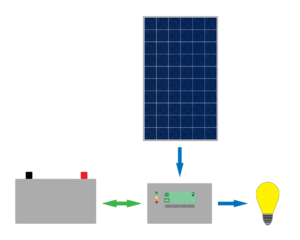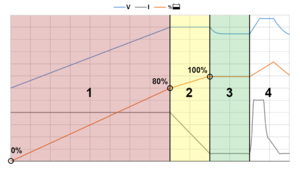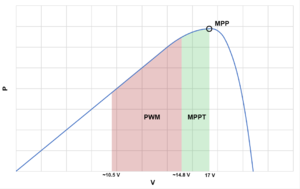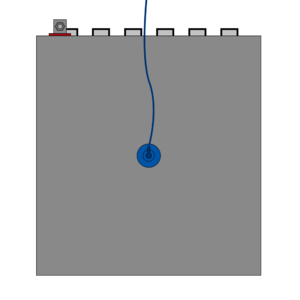Charge controller
The charge controller in an off-grid PV system serves as the connection point between the PV source and the energy storage system. Every type of energy storage has specific charging and discharging preferences that must be considered to ensure that a long life (See the article on lead acid batteries for specific details). The charge controller works to manage the incoming power from the PV source to maximize charging when the batteries can accept it and to reduce it when batteries begin nearing full. Overcharging a battery will cause the chemicals and materials in battery to breakdown and generate significant amounts of heat, which will lead to reduced battery life or permanent damage to the battery. Chronic undercharging of a battery is more common and occurs when a battery is not allowed to return to a full state of charge on a regular basis, which will lead to a buildup of sulfation on the lead plates inside of the battery which over time will reduce battery life. A charge controller often cannot protect an energy storage system from over-discharge due to the operation of loads, an off-grid system should always include a low voltage disconnect that is integrated into the charge controller, inverter or is a separate piece of equipment.
There are a variety of different charge controller designs on the market that vary greatly in voltage and current capacity, performance, functionality and cost. Investing in a quality charge controller will ensure the longevity of the other components in an off-grid PV system.
The charge controller for an off-grid system must will be sized and selected based upon the load evaluation for a particular site. This process must be done in conjunction with the sizing and selection of the PV source - see PV source and charge controller sizing and selection overview for more information.
Contents
Charging phases
All battery chargers for lead acid batteries, not just charge controllers for PV systems, follow the same basic three stage charging pattern: bulk, absorption, and float. A charge controller moves through these different stages based upon programmed voltage set points and the ambient battery temperature or ambient temperature. Smaller capacity and lower cost charge controllers may not offer the capability to program the voltage set points and will rely on values set by the manufacturer. If the charge controller does enable the programming of the voltage set points, the user manual for that specific battery should be consulted as the voltage set points vary based upon manufacturer and battery type (FLA, AGM, gel).
Bulk phase
When a battery is between 0-80% state of charge, the charge controller will send the full current of the PV source to the battery bank to bring the voltage of the system up. The charge controller will continue supplying full current in bulk mode until a certain voltage is reached, which is typically around 14.6-14.8 V for a 12 V lead acid battery.
Absorption phase
As the battery becomes fuller - at around 80% of full charge - the charge controller switches to absorption mode at which point it attempts to hold the battery bank at the maximum voltage achieved during the bulk charging phase (~14.4-14.8 V for a 12 V lead acid battery) using the minimum amount of current necessary to do so. The amount of current required to hold it at the fixed voltage decreases. The charge controller will continue in this mode until either a set amount of time has passed, or the amount of current required to hold the battery bank at a fixed voltage decreases to a programmed minimum. This typically occurs at around 95% of battery capacity.
Float phase
A battery nearing complete charge can no longer accept as much current, so the charge controller moves into the float phase, which means that it tries to hold the battery bank at a lower voltage (~13.2-13.8 V for a 12 V lead acid battery) using the minimum amount of current necessary. The slow gradually charge can bring the batteries up to a 100% state of charge.
Equalization charge
An equalization charge is not a standard charging phase, it is a planned over-charge of the batteries that can help to reduce the long-term deterioration of batteries due to a buildup of sufultion on the lead plates inside. The voltage of the battery bank may be increased as high as ~16.2V for a specified period of time. Not all charge controllers have this capability. Only flooded lead acid batteries can undergo an equalization charge. The user must either schedule or activate an equalization charge and it should only be done a day with abundant sun as the over-charge will require more energy than normal. Equalize flooded lead acid batteries at least once per month for 2 to 4 hours, longer if your batteries have been consistently undercharged. [1]
Charge controller types
There are two main types of charge controllers used in off-grid PV installations: pulse width modulation (PWM) and maximum power point tracking (MPPT). Both types of charge controllers continue to be popular as each offers distinct advantages depending upon the application.
Pulse width modulation (PWM)
A PWM charge controller measures the voltage of the battery bank and the temperature (ambient or at the battery bank) to estimate the state of charge of the battery and regulate charging. This type of charge controller can only limit the amount of current that is supplied to the energy storage system. It does not have the ability to vary the voltage of the PV source to get the maximum amount of production like a maximum power point tracking charge controllers. The charge controller and PV source must operate at the voltage of the energy storage system. This means that the PV source may be capable of operating at a higher voltage and supplying more power, but this energy will be lost as this type of charge controller does not offer this functionality.
As the charge controller cannot regulate the voltage of PV source, the modules/array must be designed to work with the voltage of the battery bank. This means that the PV source will have to operate at a relatively low voltage. There are limited module configurations that will work properly with a PWM charge controller:
- A 36-cell module is referred to as a 12 volt nominal module and will be able to supply an appropriate voltage to a 12V battery bank. These modules can be put in parallel to supply more power for a 12V battery bank or can be connected together in series (2 per series string for 24V battery bank and 4 per series string for a 48V battery bank).
- A 72-cell module is referred to as a 24V nominal module and will be able to supply an appropriate voltage to a 24V battery bank. These modules can be put in parallel to supply more power for a 24V battery bank or can be connected in series (2 per series string for a 48V battery bank).
Ratings
A PWM charge controller will be rated in terms of nominal DC system voltage and maximum current. The system designer must choose the appropriate PV source configuration based upon nominal voltage of the battery bank.
- Nominal DC system voltage: 12V, 24V, 48V
- Maximum PV source current: 6A-60A
Maximum power point tracking (MPPT)
A MPPT charge controller works similarly to a PWM charge controller in that it measures voltage of the battery and temperature to determine state of charge and regulate charging. The difference is that an MPPT charge controller can control the voltage of the PV source and the voltage that it supplies to the battery bank using more sophisticated technology and electronics. This can permit higher system performance under a more variable range of conditions and configurations. An MPPT charge controller can accept a variety of different module types and series and parallel configurations.
Ratings
A MPPT charge controller will be rated in terms of nominal DC system voltage, maximum PV source voltage, minimum PV source voltage and maximum PV source current. A system designer will have to design the PV source properly to be able to work within these parameters.
- Nominal DC system voltage: 12V, 24V, 48V
- Maximum PV source voltage: varies up to 600V
- Minimum PV source voltage: depends upon nominal voltage and charge controller type
- Maximum PV source current: up to 100A+
PWM vs MPPT comparison
The right charge controller for every application must be decided upon a variety of different factors:
- Budget - A MPPT charge controller may cost 1.5-2 times as much as a PWM charge controller, although there can be savings if it enables the use of a 60-cell or 72-cell module over a 36-cell module which typically cost more as they are produced in smaller batches.
- Flexibility - PWM charge controllers can only be used with 36-cell or 72-cell modules in specific series and parallel configurations where the operating voltage of the PV source matches the charging voltage of the energy storage system. This limits the PV source to a relatively low operating voltage. Whereas MPPT charge controllers can be used with any series and parallel configurations as long as the maximum voltage and current do not exceed the rating of the charge controller. This flexibility is an very important advantage when designing larger systems.
- Component availability - Certain charge controller types or module types may not be readily available in all locations.
- Performance - MPPT charge controller will perform better in cooler climates as they can take advantage of the higher voltage that a PV module is capable of producing.
- System size - With a smaller system the advantages of a PWM charge controller prevail, but as system size increases the benefits of a MPPT charge controller increase. At a certain system size the additional wiring required with a PWM charge controller due to parallel connections and low voltage becomes a significant pain and expense.
Additional charge controller features
There are many other additional features that charge controllers offer that may be of value on a specific project.
User interface
The user interface is important as it can conveys vital information about the state of charge of the energy storage system, which users need to revise regularly in order to be able to adjust their usage properly and protect the battery bank. A quality user interface and monitoring system can be integrated with a [[Special:MyLanguage/Shunt]shunt]] for more accurate data aobut the state of charge of the energy storage system. Additionally, a user interface should be assessed for how much programming it allows the user to perform and if it allows the revision of historical system data.
Programmability
The larger the power rating of a charge controller, typically the more user programming is permitted to enable customization according to the end user needs. There are basic functions, like the set point for the low voltage disconnect, and other more complicated functions related to battery charging and monitoring. See charge controller programming for more information.
Temperature sensor
Temperature greatly affects the voltage of a battery. The temperature of a battery often varies from the ambient temperature as heat is generated as batteries charge and discharge. Higher quality charge controllers therefore offer the option to connect an additional temperature sensor that can be connected directly to the battery bank in order to enable the charge controller to properly adjust charging based upon battery temperature. This can lead to increased system performance and longevity.
Data logging/monitoring
A data logging/monitoring system can enable the charge controller share or record data about the performance of the system. The level of detail and amount of time for which a charge controller store data varies. Information about energy production and battery bank maximum/minimum voltage can be very useful in assessing how the system is performing in that location, if the user is treating the system properly and resolving any technical issues that may arise. Some systems may also offer the capability of remote monitoring through cell phone signals or the internet, which can be very useful in remote off-grid applications if possible.
Shunt
Many charge controllers can function with a shunt to enable more accurate measurement of battery bank state of charge (SoC). The information provided by a shunt is more accurate and can allow the users to better manage and take care of their system.
Lighting controller
Many charge controllers for smaller off-grid PV systems include a DC lighting control circuit that can be used to help protect the battery bank. All systems should have some type of low voltage disconnect in order to protect the battery bank and an integrated lighting controller in a charge controller can meet this need. A lighting controller in its simplest form may automatically disconnect lights and DC loads at a certain battery voltage or in more complicated forms can be programmed to automatically turn on and run lighting loads during certain hours.
Projected life
There is no specific projected life for a charge controller as it varies significantly based upon quality and conditions of use. A low-quality charge controller may only last six months before failing, whereas a high-quality charge controller used under optimal conditions could last decades. Higher cost does not always directly translate into a high-quality charge controller, as there are very cheap PWM charge controllers on the market that are extremely well-built and durable.
Maintenance
The user manual for a charge controller should always be consulted, but most charge controllers do not require much maintenance if they are used under proper conditions. They should be kept free of dust, insects, and water. Connections should be periodically revised - at least once a year - to make sure that they are still tightened properly and not creating unnecessary resistance.
Recyclability
Charge controllers contain a variety of different materials and chemicals that can be hazardous if not disposed of properly - they should be treated as electronic waste.
Notes/references
- ↑ Trojan Battery Company - Battery Maintenance https://www.trojanbattery.com/tech-support/battery-maintenance/



